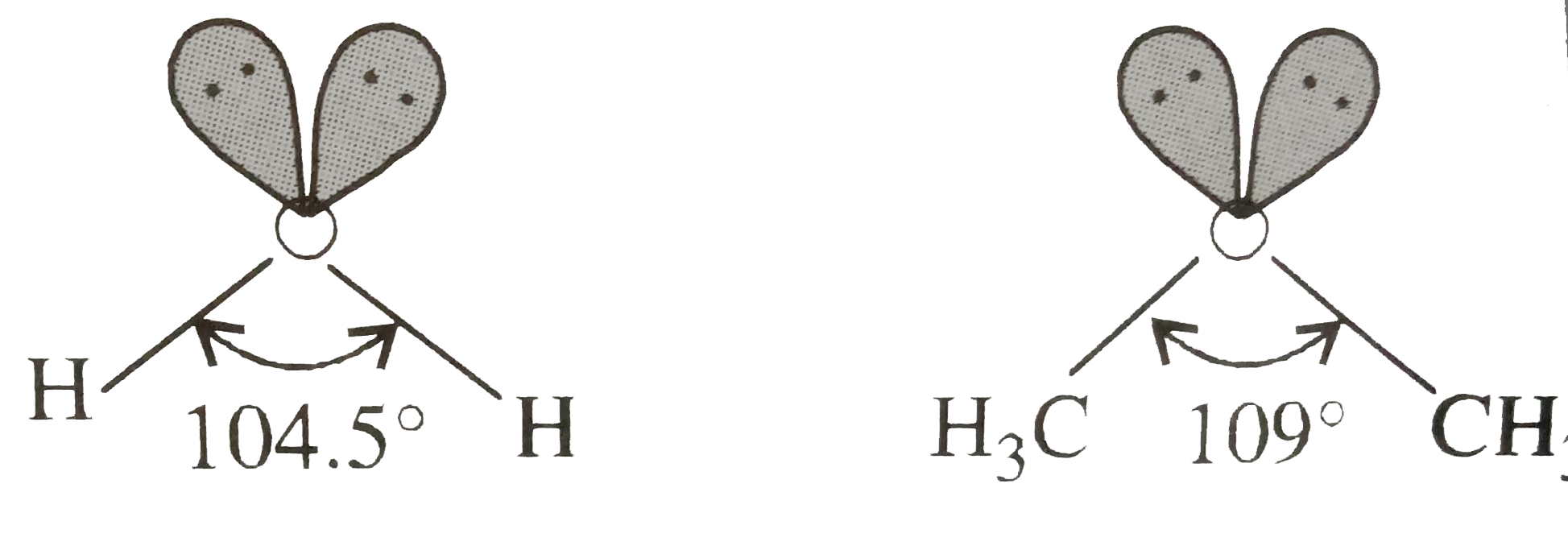In CH4,NH3 and H2O, the central atom undergoes sp3 hybridisation - yet their bond angles are different. Why ?
(i) In CH4,NH3 and H2O the central atom undergoes sp3 hybridisation. But their bond angles are different due to the presence of lone pair of electrons.
It can be explained by VSEPR theory. According to this theory, even though the hybridisation is same, the repulsive force between the bond pairs and lone pairs are not same.
(iii) Bond pair - Bond < Bond pair - Lone pair < Lone pair - Lone pair
so due to the varying repulsive force the bond pairs and lone pairs are distored from regular geometry and organise themselves in such a way that repultion will be minimum and stabily will be maximum.
(iv) In case of CH4, there are 4 bond pairs and no lone pair of electrons. So it remains in its regular geometry. i.e., tetrahedral with bond angle =190∘28.
H2O has 2 bond pairs and 2 lone pairs. There is large repsultion between lp-lp. Again repultion between lp-bp is more than that of 2 bond pairs. So 2 bond are more restricted to form inverted V shape (or) bent shape molecule with a bond angle of 104∘35.
(vi) NH3 has 3 bond pairs and 1 lone pair. There is repulsion between lp-bp. So 3 bonds are more retricted to form pyramidal shape with bond angle equal to 107∘18.
Topper's Solved these Questions
- SAMPLE PAPER - 10 (SOLVED)BOOK - FULL MARKSCHAPTER - SAMPLE PAPER - 10 (SOLVED)EXERCISE - PART - IV
10 Videos
- SAMPLE PAPER - 10 (SOLVED)BOOK - FULL MARKSCHAPTER - SAMPLE PAPER - 10 (SOLVED)EXERCISE - PART - II
9 Videos
- QUANTUM MECHANICAL MODEL OF ATOMBOOK - FULL MARKSCHAPTER - QUANTUM MECHANICAL MODEL OF ATOMEXERCISE - Additional Questions Solved (5-Mark Questions)
6 Videos
- SAMPLE PAPER -07BOOK - FULL MARKSCHAPTER - SAMPLE PAPER -07EXERCISE - PART-IV
10 Videos
Similar Questions
Knowledge Check
The central atom assume sp3 hybridisation in:
APCl3BSO3CBF3DNO−3.Which are the species in which central atom undergoes sp3 hybridisation ? .
ASF4BSCI2CSO2−4DH2OWhich of the following sp3 hybridisation central atom ?
APCl3BSO3CBF3DNO−3
In both water and dimethyl ether (CH3−..O..−CH3), oxygen atoms is central atom, and has the same hybridisation, yet they have different bond angles. Which one has greater bond angle? Give reason.
View SolutionIn both water and dimethyl ether (CH3−⋅⋅O⋅⋅−CH3), oxygen atom is central atom, and has the same hybridisation, yet they have different bond angles. Which one has greater bond angle ? Give reason.

View SolutionIn both water and dimethyl ether (CH3−⋅⋅O⋅⋅−CH3), oxygen atom is central atom, and has the same hybridisation, yet they have different bond angles. Which one has greater bond angle ? Give reason.

View SolutionAssertion (A): Though the central atom of both NH3 and H2O molecules are sp3 hybridised, yet H-N-H bond angle is greater thant that of H-O-H.
Reason(R): This is because nitrogen atom has one lone pair and oxygen atom has two lone pairs.
View SolutionAssertion (A): Though the central atom of both NH3 and H2O molecules are sp3 hybridised, yet H-N-H bond angle is greater thant that of H-O-H.
Reason(R): This is because nitrogen atom has one lone pair and oxygen atom has two lone pairs.
View Solution
